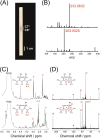Preferential formation of specific hexose and heptose in the formose reaction under microwave irradiation
- PMID: 36756559
- PMCID: PMC9890655
- DOI: 10.1039/d2ra07249a
Preferential formation of specific hexose and heptose in the formose reaction under microwave irradiation
Abstract
To realize sustainable societies, the production of organic compounds not based on fossil resources should be developed. Thus, C1 chemistry, utilizing one-carbon compounds as starting materials, has been of increasing importance. In particular, the formose reaction is promising because the reaction produces sugars (monosaccharides) from formaldehyde under basic conditions. On the other hand, since microwave (MW) induces the rotational motion of molecules, MW irradiation often improves the selectivity and efficiency of reactions. In this study, the formose reaction under MW irradiation was thus investigated under various conditions. The formose reaction proceeded very fast using 1.0 mol per kg formaldehyde and 55 mmol per kg calcium hydroxide (Ca(OH)2) as a catalyst at a high set temperature (150 °C) for a short time (1 min) to form preferentially specific hexose and heptose. The major products were isolated by thin layer chromatography and characterized by mass spectroscopy and NMR. These characterization data elucidated that the hexose and heptose were 2-hydroxymethyl-1,2,4,5-tetrahydroxy-3-pentanone (C6*) and 2,4-bis(hydroxymethyl)-1,2,4,5-tetrahydroxy-3-pentanone (C7*), respectively. On the basis of these observations, as well as density functional theory calculations, a plausible reaction pathway was also discussed; once 1,3-dihydroxyacetone is formed, consecutive aldol reactions favorably occur to form C6* and C7*.
This journal is © The Royal Society of Chemistry.
Conflict of interest statement
The authors declare no conflict of interest.
Figures



Similar articles
-
Metal-Organic Frameworks as Formose Reaction Catalysts with Enhanced Selectivity.Molecules. 2023 Aug 17;28(16):6095. doi: 10.3390/molecules28166095. Molecules. 2023. PMID: 37630347 Free PMC article.
-
Formose Reaction Controlled by a Copolymer of N,N-Dimethylacrylamide and 4-Vinylphenylboronic Acid.Polymers (Basel). 2017 Oct 25;9(11):549. doi: 10.3390/polym9110549. Polymers (Basel). 2017. PMID: 30965856 Free PMC article.
-
Serpentinization-Associated Mineral Catalysis of the Protometabolic Formose System.Life (Basel). 2023 May 31;13(6):1297. doi: 10.3390/life13061297. Life (Basel). 2023. PMID: 37374080 Free PMC article.
-
Catalytic formation of monosaccharides: from the formose reaction towards selective synthesis.ChemSusChem. 2014 Jul;7(7):1833-46. doi: 10.1002/cssc.201400040. Epub 2014 Jun 16. ChemSusChem. 2014. PMID: 24930572 Review.
-
Microwave-induced Bismuth Salts-mediated Synthesis of Molecules of Medicinal Interests.Curr Med Chem. 2017;24(41):4677-4713. doi: 10.2174/0929867324666170320121142. Curr Med Chem. 2017. PMID: 28322155 Review.
Cited by
-
The second wave of formose research.BBA Adv. 2025 Jan 17;7:100141. doi: 10.1016/j.bbadva.2025.100141. eCollection 2025. BBA Adv. 2025. PMID: 39974666 Free PMC article.
-
Metal-Organic Frameworks as Formose Reaction Catalysts with Enhanced Selectivity.Molecules. 2023 Aug 17;28(16):6095. doi: 10.3390/molecules28166095. Molecules. 2023. PMID: 37630347 Free PMC article.
References
-
- Handbook of Petrochemicals Production Processes, ed. R. A. Meyers, McGraw-Hill, New York, 2019
-
- Ragauskas A. J. Williams C. K. Davison B. H. Britovsek G. Cairney J. Eckert C. A. Frederick W. J. Hallett J. P. Leak D. J. Liotta C. L. Mielenz J. R. Murphy R. Templer R. Tschaplinski T. Science. 2006;311:484–489. - PubMed
-
- Himmel M. E. Ding S.-Y. Johnson D. K. Adney W. S. Nimlos M. R. Brady J. W. Foust T. D. Science. 2007;315:804–807. - PubMed
-
- Hu L. Zhao G. Hao W. Tang X. Sun Y. Lin L. Liu S. RSC Adv. 2012;2:11184–11206.
-
- Singhvi M. Gokhale D. RSC Adv. 2013;3:13558–13568.
LinkOut - more resources
Full Text Sources
Miscellaneous

